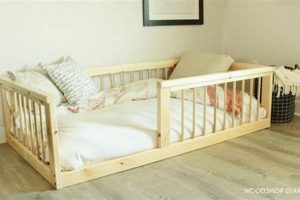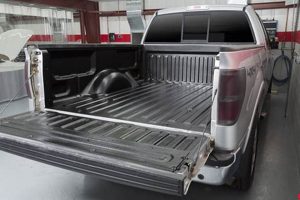Components providing support to a mattress within a bed frame, often constructed from wood, can be created through do-it-yourself methods. These elements, typically arranged in a series across the frame, distribute weight and contribute to overall sleeping comfort. For example, individuals may choose to construct these supports using readily available lumber and basic woodworking tools to fit custom bed frame dimensions.
Adequate mattress support is essential for promoting proper spinal alignment and extending the lifespan of the mattress. Historically, various materials have served this purpose; however, wooden components offer a balance of affordability and durability. Creating these supports independently allows for customization to meet specific needs, potentially resulting in cost savings compared to purchasing pre-made alternatives. This approach also promotes resourcefulness and the development of practical skills.
Subsequent sections will detail material selection, necessary tools, step-by-step construction processes, and considerations for optimizing design to ensure adequate structural integrity and enhance sleep quality.
Essential Considerations for Creating Bed Supports
The following points offer critical guidance during the design and construction of wooden mattress supports. Adherence to these recommendations will contribute to structural soundness and user satisfaction.
Tip 1: Material Selection is Paramount. Opt for hardwoods like maple, oak, or poplar for enhanced durability and resistance to warping. Softwoods, while more cost-effective, may require closer spacing to prevent sagging under weight.
Tip 2: Precise Measurement Ensures Proper Fit. Accurately measure the interior dimensions of the bed frame to determine the required length and width. Inaccurate measurements can lead to instability or render the supports unusable.
Tip 3: Consistent Spacing Maximizes Support. Maintain uniform intervals between each support element. Excessive gaps can cause mattress indentations and uneven weight distribution, compromising sleep quality.
Tip 4: Secure Attachment Prevents Movement. Implement a reliable method for securing the support elements to the bed frame. Options include screws, brackets, or integrated support ledges. Loose supports can shift and create noise.
Tip 5: Surface Treatment Enhances Longevity. Apply a protective finish, such as varnish or sealant, to the wood. This will safeguard against moisture damage, insect infestation, and wear, extending the lifespan of the components.
Tip 6: Consider Center Support for Larger Beds. Queen and king-size beds benefit from a center support beam and corresponding supports. This prevents sagging in the middle of the mattress and enhances overall stability.
Sound construction principles and careful attention to detail are critical. Investing time in these aspects during the creation phase will translate to long-term benefits.
These considerations should be integrated with the earlier guidance on materials and methods for optimal outcome.
1. Material Strength
Material strength is a primary determinant of the load-bearing capacity and overall longevity. The capacity to withstand stress and strain without deformation or fracture is directly related to the choice of material. For instance, a design using a low-density softwood like pine requires more supports spaced closely together to achieve the same level of support as one using a high-density hardwood like oak. Failure to adequately consider material strength can result in sagging, breakage, and compromised mattress support. This, in turn, can lead to discomfort, reduced mattress lifespan, and potential structural failure of the bed frame.
The selection of appropriate materials is further influenced by the intended use and the weight of the mattress and occupants. A bed designed for a single individual using a lightweight foam mattress will have different material requirements compared to a bed intended for two adults with a heavy innerspring mattress. Furthermore, the method of construction impacts the stress distribution within each element. For example, a wider, thicker support will generally exhibit greater resistance to bending than a narrow, thin support of the same material. Therefore, the design must account for both the material’s intrinsic strength and the way it is incorporated into the overall structure.
In summary, neglecting the importance of material strength can lead to unsatisfactory outcomes and potential hazards. Selection should be based on a comprehensive assessment of the anticipated load, the method of construction, and the inherent properties of the materials used. A well-informed approach to material selection is essential for creating a durable and effective support system.
2. Frame Integration
Effective frame integration constitutes a critical determinant in the performance and longevity of do-it-yourself bed supports. This aspect encompasses the method by which the supports are connected to the existing bed frame structure, and it directly influences the distribution of weight, overall stability, and prevention of component failure. Inadequate frame integration can lead to instability, uneven weight distribution, and premature wear of both the support structure and the mattress. For example, if support components are simply resting within the frame without secure attachment, lateral movement and shifting can occur, resulting in discomfort and potential damage.
Securement methods can vary depending on the design of the bed frame and the materials used for the support components. Common techniques include the use of screws, bolts, or specialized brackets to firmly attach the supports to side rails or interior ledges within the frame. In cases where the bed frame lacks existing support structures, the construction of integrated ledges or the addition of a central support beam may be necessary to provide adequate load-bearing capacity. Furthermore, the type of fastener employed should be appropriate for the materials being joined. For instance, using screws that are too short or too thin may result in a weak connection that is prone to failure under load. The alignment and spacing of fasteners are also important considerations, as uneven distribution can concentrate stress and weaken the connection.
In summary, frame integration is not merely a cosmetic detail but rather a fundamental element that influences the structural integrity of do-it-yourself bed support systems. Proper integration techniques ensure stability, promote even weight distribution, and contribute to the long-term durability of the bed. Neglecting this aspect can lead to compromised performance and potential safety hazards. Therefore, careful planning and execution of frame integration are essential for a successful project.
3. Load Distribution
Effective load distribution is a critical factor in the design and implementation of do-it-yourself bed support systems. This principle governs how weight is dispersed across the surface, influencing mattress longevity, user comfort, and the structural integrity of the bed frame itself. Understanding the facets of load distribution is therefore essential for constructing durable and functional bed supports.
- Support Spacing and Density
The proximity of individual support elements directly impacts how weight is distributed. Closer spacing results in more uniform load transfer, reducing stress concentrations on the mattress. Conversely, wider spacing may lead to sagging and uneven wear. The density of supports should be determined based on the mattress type, weight of occupants, and material strength.
- Material Rigidity and Flexibility
The inherent properties of the chosen material dictate how effectively it distributes weight. Rigid materials, such as hardwood, offer consistent support but may lack flexibility to conform to mattress contours. More flexible materials, such as certain engineered woods, can distribute load more evenly but may be prone to sagging over time. Selection should balance support and adaptability.
- Support Surface Area and Contact
The width and surface area of each support element affect the pressure exerted on the mattress. Wider supports distribute weight over a larger area, reducing stress concentrations. Smooth, consistent contact between the support and mattress is essential to prevent localized wear and potential damage.
- Frame Integration and Structural Integrity
The manner in which support elements are integrated into the bed frame significantly influences load distribution. Secure, stable connections ensure that weight is transferred evenly to the frame, preventing localized stress points. The overall structural integrity of the frame is equally important, as a weak frame may fail under unevenly distributed load.
These interconnected facets demonstrate that load distribution is a multifaceted consideration in the construction of do-it-yourself bed supports. Addressing each aspect effectively is crucial for maximizing mattress lifespan, enhancing user comfort, and ensuring the long-term stability of the bed frame. Optimizing load distribution requires careful planning, material selection, and precise execution during the building process.
4. Proper Spacing
The distance between individual support elements in a do-it-yourself bed support system directly influences the distribution of weight across the mattress surface. Insufficient spacing can lead to localized sagging and premature wear of the mattress, particularly in areas subjected to greater pressure. Conversely, excessive spacing compromises overall support, potentially causing discomfort and affecting spinal alignment. Proper spacing, therefore, represents a critical component in the design and construction of effective DIY bed supports, directly impacting their performance and longevity.
Determining optimal spacing requires consideration of several factors, including mattress type, intended weight load, and material properties. For instance, heavier innerspring mattresses typically require closer spacing than lighter foam mattresses to prevent indentation between supports. Similarly, softer wood species necessitate reduced spacing compared to denser hardwoods to achieve comparable levels of support. A common approach involves adhering to manufacturer recommendations for mattress support, adjusting spacing accordingly based on the chosen materials and design. Failure to account for these variables can result in uneven weight distribution, discomfort, and reduced mattress lifespan. For example, a queen-sized bed with widely spaced supports might exhibit sagging in the center, while one with closely spaced supports offers uniform support and extends mattress life.
Ultimately, proper spacing in DIY bed support construction is a balancing act between providing adequate support, promoting even weight distribution, and preventing premature mattress wear. Careful consideration of material properties, mattress characteristics, and anticipated load is essential for achieving optimal results. By adhering to sound design principles and paying attention to detail, individuals can create effective and durable support systems that enhance sleep quality and extend the lifespan of their mattress.
5. Secure Fastening
Secure fastening represents a crucial element in the successful creation and functionality of do-it-yourself bed supports. It directly affects the stability, weight-bearing capacity, and long-term reliability of the entire sleeping platform. The method by which these components are joined to the bed frame, and to each other, dictates the degree to which the structure can withstand the stresses and strains of regular use. Improperly secured supports can shift, loosen, or even collapse under load, leading to discomfort, potential injury, and damage to the mattress. For instance, a support system assembled with inadequate screws or without proper bracing is likely to fail prematurely, particularly under the weight of multiple occupants. Therefore, selecting appropriate fastening techniques and employing them diligently is of paramount importance.
Various fastening methods can be utilized, each with its own advantages and disadvantages. Screws, bolts, and specialized brackets are common choices. The selection should be based on the type of materials being joined and the anticipated load. Screws are often suitable for attaching supports to wooden bed frames, while bolts may be preferable for greater strength and durability. Brackets can provide additional support and prevent racking. Regardless of the chosen method, it is essential to ensure that fasteners are properly sized, positioned, and tightened. Over-tightening can strip threads or damage the surrounding material, while under-tightening can lead to loosening over time. Applying wood glue in conjunction with mechanical fasteners can further enhance joint strength and prevent movement. Real-world examples include support systems constructed with robust metal brackets and bolts in high-traffic areas such as rental properties, where durability is paramount.
In summary, secure fastening is not merely a perfunctory step in the construction of do-it-yourself bed supports but a critical factor influencing their overall performance and safety. A thorough understanding of available fastening methods, proper material selection, and diligent execution are essential for creating a stable and reliable sleeping surface. Neglecting this aspect can compromise the structural integrity of the bed and potentially lead to undesirable outcomes. Consequently, prioritizing secure fastening is a fundamental principle in any successful DIY bed project.
6. Dimensional Accuracy
Dimensional accuracy is a fundamental prerequisite for the successful design, construction, and functionality of do-it-yourself bed supports. Precise measurements and adherence to specified dimensions are essential for ensuring proper fit, structural integrity, and overall stability of the bed frame. Deviations from accurate dimensions can result in misalignment, uneven weight distribution, and compromised support, ultimately affecting the comfort and longevity of the mattress and the safety of the occupants.
- Frame Fit and Alignment
Accurate measurement of the bed frame’s internal dimensions is crucial for creating supports that fit snugly and securely. Supports that are too long will not fit properly, while those that are too short will create gaps and instability. Precise alignment is equally important to ensure that the supports are level and evenly distribute weight across the mattress. For example, if one support is slightly longer than the others, it will bear a disproportionate amount of weight, potentially leading to stress fractures and premature failure. Precise cut of lumber components is essential in this stage.
- Spacing Consistency
Maintaining consistent spacing between individual support elements is essential for even weight distribution and prevention of mattress sagging. Inaccurate dimensions can result in inconsistent spacing, creating localized areas of high stress and premature wear. For instance, if the spacing between supports varies by even a small amount, the mattress may develop indentations in the areas where the supports are farther apart, while the areas where the supports are closer together may experience increased pressure. Each dimension should be thoroughly checked for proper spacing intervals.
- Structural Integrity and Stability
Accurate dimensions contribute directly to the structural integrity and stability of the overall support system. Supports that are not precisely cut or joined may create weak points in the structure, making it more susceptible to failure under load. For example, if support elements are not square or if their connections are not flush, the entire structure may be prone to racking or collapse. Thus, appropriate dimensions and angles should be checked and re-checked to prevent faulty construction.
- Material Utilization and Waste Reduction
Precise measurement and cutting minimize material waste and ensure efficient utilization of resources. Inaccurate dimensions can lead to the need for re-cutting or replacement of components, resulting in increased material costs and environmental impact. For example, a cut that is too short renders the length unusable and creates waste material. Proper planning and measurement is paramount for efficient material usage.
These interconnected facets highlight the critical importance of dimensional accuracy in the construction of do-it-yourself bed supports. Adherence to precise measurements and dimensions is essential for ensuring proper fit, structural integrity, and long-term performance. By prioritizing dimensional accuracy throughout the building process, individuals can create durable and functional support systems that enhance sleep quality and extend the lifespan of their mattresses.
7. Support Durability
The longevity of a do-it-yourself bed support system, constructed from individual elements, is paramount to its overall effectiveness. Support durability, defined as the capacity to withstand sustained load and resist degradation over time, directly impacts the lifespan of the mattress, the safety of the user, and the economic value of the construction effort. The materials selected, the construction techniques employed, and the environmental conditions to which the structure is exposed all contribute to its overall durability. A system built with inferior materials or flawed joinery will inevitably fail prematurely, requiring costly repairs or complete replacement. For instance, supports made from untreated softwood in a humid environment are susceptible to rot and insect infestation, leading to structural weakening and eventual collapse.
The interaction between individual support components and the bed frame is also critical for ensuring long-term durability. Secure fastening methods, such as screws, bolts, or brackets, are essential for preventing movement and distributing weight evenly. Insufficient or improperly installed fasteners can lead to loosening over time, compromising the stability of the entire structure. Furthermore, the design of the support system should account for potential stress points and incorporate reinforcement measures as needed. For example, wider supports or the addition of a central support beam can help to distribute weight more effectively and prevent sagging in the middle of the bed. Proper maintenance, such as periodic inspection and tightening of fasteners, can also extend the lifespan of the supports. Consider, for example, wooden elements reinforced with metal strips, commonly seen in antique bed frames, showcasing methods for enhancing long-term durability.
In summation, the durability of self-made bed support elements is a multifaceted attribute determined by material selection, construction methods, and environmental factors. Prioritizing durability is crucial for ensuring the long-term performance, safety, and economic viability of the bed. Addressing all contributing factors through careful planning and diligent execution will result in a stable and reliable sleeping surface that provides years of service. Challenges exist in predicting lifespan due to varying user weight and environmental conditions, requiring a margin of safety in design and construction to accommodate potential extremes.
Frequently Asked Questions
The following section addresses common inquiries regarding the design, construction, and maintenance of independently created bed support systems. Information presented is intended to provide clarity and promote informed decision-making.
Question 1: What is the recommended material for creating durable bed support elements?
Hardwoods such as oak, maple, or poplar offer superior strength and resistance to warping compared to softwoods like pine or fir. Selection should be based on anticipated load and environmental conditions.
Question 2: How does support spacing influence mattress performance?
Inadequate spacing can lead to mattress sagging and uneven wear. Optimal spacing depends on mattress type, weight distribution, and material properties of the supports. Closer spacing generally provides greater support.
Question 3: What are the crucial considerations for ensuring secure attachment to the bed frame?
Fasteners such as screws, bolts, or brackets should be appropriately sized and securely installed. The chosen method should prevent movement and distribute weight evenly across the frame. Wood glue can enhance joint strength.
Question 4: Why is dimensional accuracy essential in constructing bed supports?
Precise measurements ensure proper fit, alignment, and even weight distribution. Inaccurate dimensions can compromise structural integrity and lead to instability or premature failure.
Question 5: How can the lifespan of constructed bed supports be maximized?
Selecting durable materials, employing robust construction techniques, and providing regular maintenance are crucial. Applying a protective finish and periodically inspecting fasteners can extend lifespan.
Question 6: Is center support necessary for larger beds?
Queen and king-size beds benefit from a center support beam and corresponding supports. This prevents sagging in the middle of the mattress and enhances overall stability, crucial for larger sleeping platforms.
Understanding these key aspects is crucial for designing and building reliable bed support systems. Implementing recommended practices contributes to enhanced sleep quality and extended mattress lifespan.
The following section presents advanced design considerations to further optimize self-made bed supports.
Conclusion
This exploration of `diy bed slats` has underscored the critical factors influencing their design, construction, and long-term performance. Material selection, dimensional accuracy, secure fastening, and load distribution emerged as central considerations. A comprehensive understanding of these elements is paramount to creating a support system that provides adequate mattress support, enhances user comfort, and ensures structural integrity.
Effective implementation of these principles represents a significant investment in the quality and longevity of sleep infrastructure. Rigorous attention to detail throughout the construction process will yield a durable, reliable, and cost-effective alternative to commercially manufactured options. Continuous evaluation and refinement of construction techniques are encouraged to optimize performance and promote innovation in this practical domain.







